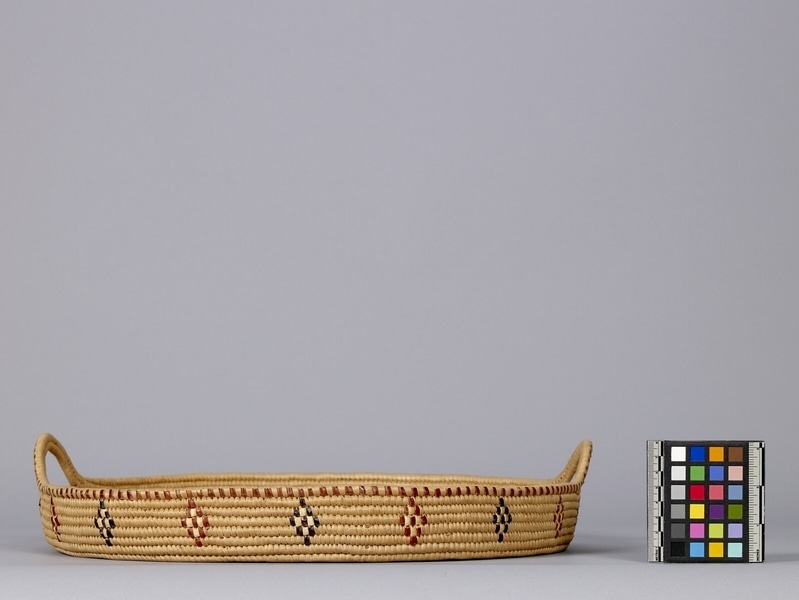Basketry Tray Item Number: A7260 from the MOA: University of British Columbia



Description
Round, coiled work, cedar root tray. Watch-spring base construction; sides of seven coiled rows; coiled work handles. Beaded and imbricated designs consist of six radiating rows of two-and-a half diamond shapes in red cherry bark and grass, or black dyed cherry bark and grass. In between the rows, on the outer edge, there are six "z" shapes in red or black cherry bark. Sides are decorated with diamond shapes.
History Of Use
Coiled basketry traditionally had many uses. It was used for storage of foods, medicines and personal belongings. Some baskets were used for cooking and boiling water, while others had more private uses. Haeberlin and Teit (1928) suggest that in the past not all women were basket makers, but that the skill became more widespread during the early and middle twentieth century when basketry was highly collectible and it became a source of income for many local First Nations women. Basket making declined after the 1950s, but it is still present in many Coast Salish communities and interest is growing.
Cultural Context
basketry; storage
Specific Techniques
Black cherry bark is obtained by dyeing the naturally red bark. In the past, basket makers buried the bark in a dark swampy soil with a high iron content in order to turn it black. Today, many basket makers submerge their bark in water with pieces of rusty metal, such as nails. However, some basket makers feel that this latter method may not be color fast and may stain adjacent materials over time.
Item History
- Made in British Columbia, Canada before 1928
- Collected in North Vancouver, British Columbia, Canada between 1925 and 1928
- Owned by Sheila Buchanan and G. S. Scholefield before July 1960
- Received from Sheila Buchanan (Donor) and G. S. Scholefield (Donor) during July 1960
What
- Name
- Basketry Tray
- Identification Number
- A7260
- Type of Item
- tray
- Material
- cedar root, grass, cherry bark and dye
- Manufacturing Technique
- imbricated, dyed and coiled
- Overall
- height 8.9 cm, diameter 40.0 cm
Who
- Culture
- Coast Salish: Squamish
- Previous Owner
- Sheila Buchanan and G. S. Scholefield
- Received from
- Sheila Buchanan (Donor) and G. S. Scholefield (Donor)
Where
- Holding Institution
- MOA: University of British Columbia
- Made in
- British Columbia, Canada
- Collected in
- North Vancouver, British Columbia, Canada
When
- Creation Date
- before 1928
- Collection Date
- between 1925 and 1928
- Ownership Date
- before July 1960
- Acquisition Date
- during July 1960
Other
- Item Classes
- basketry
- Condition
- good
- Accession Number
- 0021/0009